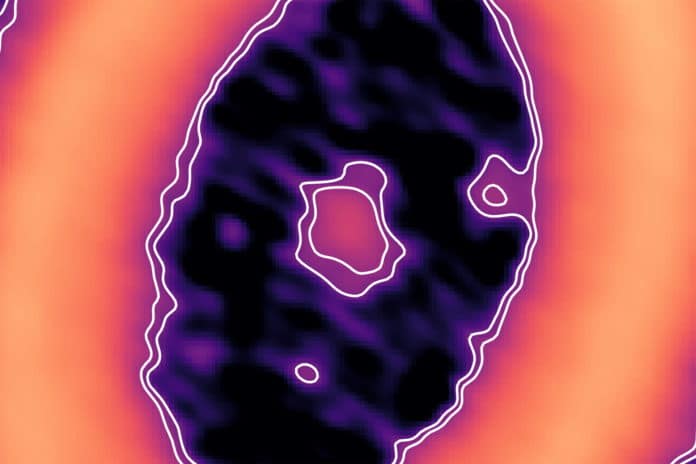Astronomers, using the world’s most powerful array of radio telescopes, the Atacama Large Millimeter/submillimeter Array (ALMA) in Chile, observed a circumplanetary disk of gas and dust like the one that is believed to have birthed the moons of Jupiter. The disk can form moons and is made of gas, dust, and asteroid fragments.
The planet named PDS 70c, located 370 light-years from Earth, was first revealed in visible light images last month.
Observations from the telescope indicated that dust was present around two planets in the system – PDS 70 c and PDS 70 b – suggesting that gas disks surrounded them.
Rice University astronomer Andrea Isella said, “Planets form from disks of gas and dust around newly forming stars, and if a planet is large enough, it can form its disk as it gathers material in its orbit around the star. Jupiter and its moons are a little planetary system within our solar system, for example, and it’s believed Jupiter’s moons formed from a circumplanetary disk when Jupiter was very young.”
Planets with such circumplanetary disks usually disappear within about 10 million years. It means circumplanetary disks haven’t existed in our solar system for more than 4 billion years. Studying such clouds can provide vital information on planets’ formation, which is why this finding is exciting for astronomers.
To observe them elsewhere, astronomers search for very young star systems where they can directly observe disks and the planets still forming inside them. In the new study, Isella and colleagues analyzed observations made by ALMA in 2017.
Isella said, “There are a handful of candidate planets that have been detected in disks, but this is a very new field, and they are all still debated. (PDS 70 b and PDS 70 c) are among the most robust because there have been independent observations with different instruments and techniques.”
“There’s much that we don’t understand about how planets form, and we now finally have the instruments to make direct observations and begin answering questions about how our solar system formed and how other planets might form.”
Study co-authors include Myriam Benisty of both the Universidad de Chile and the Université Grenoble Alpes, Richard Teague of the University of Michigan, Jaehan Bae of the Carnegie Institution for Science, Miriam Keppler of the Max Planck Institute for Astronomy, Stefano Facchini of the European Southern Observatory and Laura Pérez of the Universidad de Chile.
The research was supported by the National Science Foundation, the French National Research Agency, NASA, the Chilean National Commission for Scientific and Technological Research, the Chilean National Fund for Scientific and Technological Development, European Union Horizon 2020, and the European Southern Observatory.
Journal Reference
- Andrea Isella, Myriam Benisty, Richard Teague, Jaehan Bae, Miriam Keppler, Stefano Facchini, and Laura Pérez. Detection of Continuum Submillimeter Emission Associated with Candidate Protoplanets. 2019 the Astrophysical Journal Letters 879 L25. DOI 10.3847/2041-8213/ab2a12.
